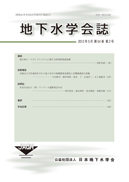All issues

Volume 39 (1997)
- Issue 4 Pages 287-
- Issue 3 Pages 187-
- Issue 2 Pages 87-
- Issue 1 Pages 1-
Volume 39, Issue 3
Displaying 1-5 of 5 articles from this issue
- |<
- <
- 1
- >
- >|
-
Takashi IKEGUCHI1997Volume 39Issue 3 Pages 187-199
Published: August 25, 1997
Released on J-STAGE: December 11, 2012
JOURNAL FREE ACCESSConsidering a limitation of available land for waste landfilling, the amount of waste directed to landfill sites should be minimized by reduction, reuse and recycling. Besides a constraint of waste volume, characteristics of waste filled has been changed recently in the manner that pollutants including hazardous substances are concentrated in waste as regulation of water and air emission is strengthened. Thus the landfill site has an important role as a final barrier to control a flow of hazardous substances in the environment. Above all a lining system is required to prevent groundwater pollution by leachate released from waste body in conjunction with a front check system of incoming waste, groundwater monitoring, and leachate treatment. A new design criteria or philosophy of waste landfills should be developed to prevent groundwater pollution since those technologies currently available are rather new and thus less promising with a lot of uncertainty.View full abstractDownload PDF (2162K) -
Shinji NAKAYA, Akihisa KOIKE, Masato HORIE, Tetsuhiro HIRAYAMA, Toshia ...1997Volume 39Issue 3 Pages 201-215
Published: August 25, 1997
Released on J-STAGE: December 11, 2012
JOURNAL FREE ACCESSSpecific storage, one of the hydraulic constants, is defined as a rate of volume change caused by the elastic deformation of structural skeleton and pore water in a porous media associating with changing hydraulic pressure. In this report,, the specific storage was theoretically estimated from the combination of compressibility of skeleton of rock mass, compressibility and density of pore water, and porosity.
The basement rocks of the studied area, mainly composed of rhyolitic welded tuff, are considerably fractured from the observation of the survey tunnels having a total length of 300 meters and of the vertically drilled four bore-holes to the tunnels. The basement rocks also have high permeability, determined from the Lugeon water tests carried out at about four bore-holes. Hydraulic conductivities and specific storages have precisely been determined by the cross-hole hydraulic pressure tests performed at selected four bore-holes. An apparent principal hydraulic direction can be distinguishable from the differences of hydraulic pressure propagation among horizontal three directions during cross-hole hydraulic pressure tests. The specific storage value is larger in the apparently minimum principal hydraulic direction than that in the maximum principal hydraulic direction.
The compressibility of skeleton was determined from the data of elastic wave exploration around survey tunnels and bore-hole horizontal loading test at several bore-holes. The specific storage of a fractured rock mass can be calculated from the combination of the compressibility of skeleton, compressibility and density of pore-water and porosity. Consequently, the calculated specific storages is concordant with that of the apparent minimum principal hydraulic direction. Specific storages of the apparent maximum principal hydraulic direction have smaller of 2 orders and more than those calculated above. The smaller values are explained that volume of the pore in fractures varies with ground water seepage along the apparent maximum principal hydraulic direction without the volume change of the rock skeleton. When the rock skeleton along the apparent maximum principal hydraulic direction has no volume change associating with seepage flow, the specific storage is given by the product of compressibility and density of pore water, porosity and coefficient, α, where α is the ratio of pore volume in the main flow paths, which volume changes during seepage flow, to total pore volume. In the studied rock mass here, α ranges from 0.07 to 1.3. The α is smaller than 1, because ground water flows in a part of fractures which regard as channels, and the storage of the ground water is due to the volume change of a certain part of pore space in the main ground water flow path.View full abstractDownload PDF (1918K) -
[in Japanese]1997Volume 39Issue 3 Pages 217-228
Published: August 25, 1997
Released on J-STAGE: December 11, 2012
JOURNAL FREE ACCESSDownload PDF (4829K) -
[in Japanese]1997Volume 39Issue 3 Pages 229-239
Published: August 25, 1997
Released on J-STAGE: December 11, 2012
JOURNAL FREE ACCESSDownload PDF (4074K) -
Yoshinori SATO1997Volume 39Issue 3 Pages 241-250_1
Published: August 25, 1997
Released on J-STAGE: December 11, 2012
JOURNAL FREE ACCESSDownload PDF (18973K)
- |<
- <
- 1
- >
- >|